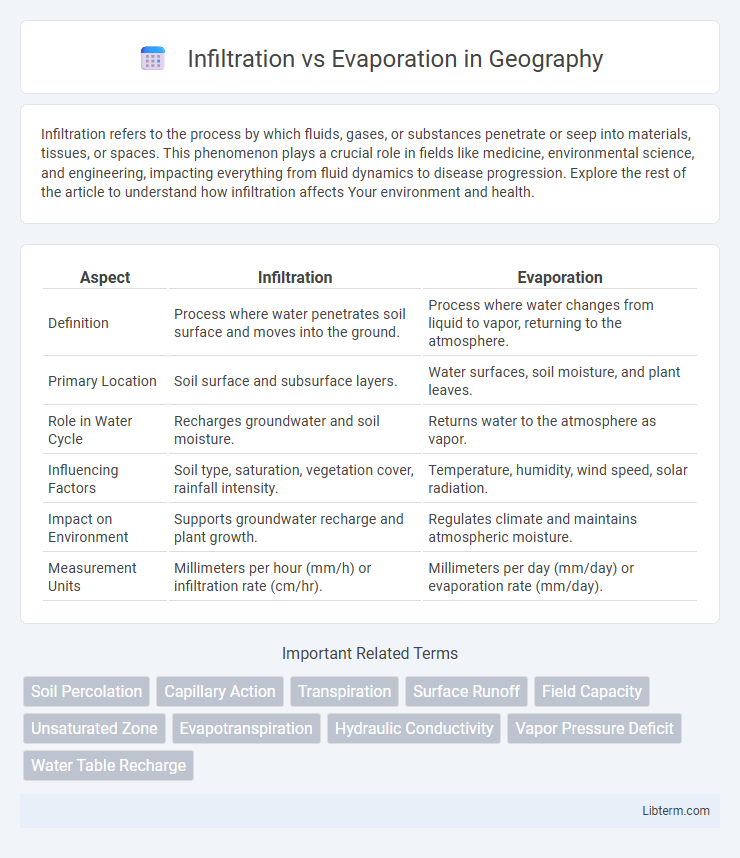Infiltration refers to the process by which fluids, gases, or substances penetrate or seep into materials, tissues, or spaces. This phenomenon plays a crucial role in fields like medicine, environmental science, and engineering, impacting everything from fluid dynamics to disease progression. Explore the rest of the article to understand how infiltration affects Your environment and health.
Table of Comparison
| Aspect | Infiltration | Evaporation |
|---|---|---|
| Definition | Process where water penetrates soil surface and moves into the ground. | Process where water changes from liquid to vapor, returning to the atmosphere. |
| Primary Location | Soil surface and subsurface layers. | Water surfaces, soil moisture, and plant leaves. |
| Role in Water Cycle | Recharges groundwater and soil moisture. | Returns water to the atmosphere as vapor. |
| Influencing Factors | Soil type, saturation, vegetation cover, rainfall intensity. | Temperature, humidity, wind speed, solar radiation. |
| Impact on Environment | Supports groundwater recharge and plant growth. | Regulates climate and maintains atmospheric moisture. |
| Measurement Units | Millimeters per hour (mm/h) or infiltration rate (cm/hr). | Millimeters per day (mm/day) or evaporation rate (mm/day). |
Introduction to Infiltration and Evaporation
Infiltration refers to the process by which water on the ground surface enters the soil, influenced by soil type, moisture content, and land slope. Evaporation is the transformation of water from liquid form to vapor from surfaces such as soil and water bodies, affected by temperature, humidity, and wind speed. Understanding both processes is essential for managing soil moisture and water cycles in agriculture and hydrology.
Definitions: What is Infiltration?
Infiltration refers to the process by which water on the ground surface enters the soil, moving downward through the soil pores and cracks. It plays a crucial role in replenishing groundwater and maintaining soil moisture levels, affecting agricultural productivity and ecosystem health. Infiltration rates depend on factors such as soil texture, vegetation cover, and land slope.
Definitions: What is Evaporation?
Evaporation is the process by which water changes from a liquid state to a vapor or gas state, primarily driven by solar energy and ambient temperature. It plays a crucial role in the hydrological cycle by transferring moisture from soil, water bodies, and plants into the atmosphere. Unlike infiltration, which involves water seeping into the ground, evaporation leads to the loss of surface water into the air, affecting soil moisture levels and weather patterns.
The Science Behind Infiltration
Infiltration refers to the process by which water on the ground surface enters the soil, driven by soil properties such as porosity, texture, and structure. Unlike evaporation, which converts liquid water into vapor due to solar radiation and atmospheric conditions, infiltration influences groundwater recharge and soil moisture levels essential for plant growth. Soil permeability and saturation levels critically determine the rate of infiltration, impacting hydrological cycles and ecosystem sustainability.
The Science Behind Evaporation
Evaporation is a physical process where liquid water molecules gain enough energy to transition into a gaseous state, driven by solar radiation and temperature gradients. This phase change plays a crucial role in the hydrological cycle, influencing soil moisture, atmospheric humidity, and climate regulation. Evaporation rates depend on factors such as surface area, air temperature, humidity, and wind velocity, distinguishing it fundamentally from infiltration, which involves water seeping into soil layers.
Key Differences Between Infiltration and Evaporation
Infiltration refers to the process where water penetrates and soaks into the soil, replenishing groundwater and affecting soil moisture levels, while evaporation involves the transformation of liquid water from surfaces such as soil and water bodies into water vapor, returning it to the atmosphere. Key differences between infiltration and evaporation include their roles in the water cycle, with infiltration contributing primarily to groundwater recharge and soil hydration, whereas evaporation drives atmospheric moisture and climate regulation. Furthermore, infiltration rates depend on soil permeability and texture, whereas evaporation rates are influenced by temperature, humidity, wind speed, and solar radiation.
Factors Influencing Infiltration Rates
Soil texture, structure, and moisture content significantly influence infiltration rates, with sandy soils allowing quicker water entry compared to clayey soils due to larger pore spaces. Vegetation cover impacts infiltration by protecting soil from compaction and enhancing organic matter, which improves permeability. Rainfall intensity and land slope also play crucial roles, as excessive rain or steep slopes can reduce infiltration by promoting runoff.
Factors Influencing Evaporation Rates
Evaporation rates depend primarily on temperature, humidity, wind speed, and surface area of the exposed water. Higher temperatures increase molecular energy, accelerating evaporation, while low humidity creates a greater vapor pressure gradient that enhances moisture transfer. Wind removes saturated air near the surface, maintaining a steady evaporation gradient, and larger surface areas allow more water molecules to escape into the air.
Importance in the Water Cycle
Infiltration plays a crucial role in replenishing groundwater reservoirs, maintaining soil moisture, and supporting vegetation growth within the water cycle. Evaporation facilitates the transformation of liquid water into vapor, driving atmospheric moisture circulation and cloud formation essential for precipitation. Both processes interconnect to regulate water distribution, sustain ecosystems, and influence climate patterns globally.
Applications and Environmental Impacts
Infiltration plays a crucial role in groundwater recharge, irrigation efficiency, and stormwater management, supporting sustainable agriculture and reducing urban flooding risks. Evaporation impacts water cycle dynamics, influencing climate regulation, irrigation water requirements, and the effectiveness of cooling systems in industrial processes. Both processes significantly affect soil moisture retention, ecosystem health, and water resource availability, making their management vital for environmental preservation and adaptation to climate change.
Infiltration Infographic

 libterm.com
libterm.com